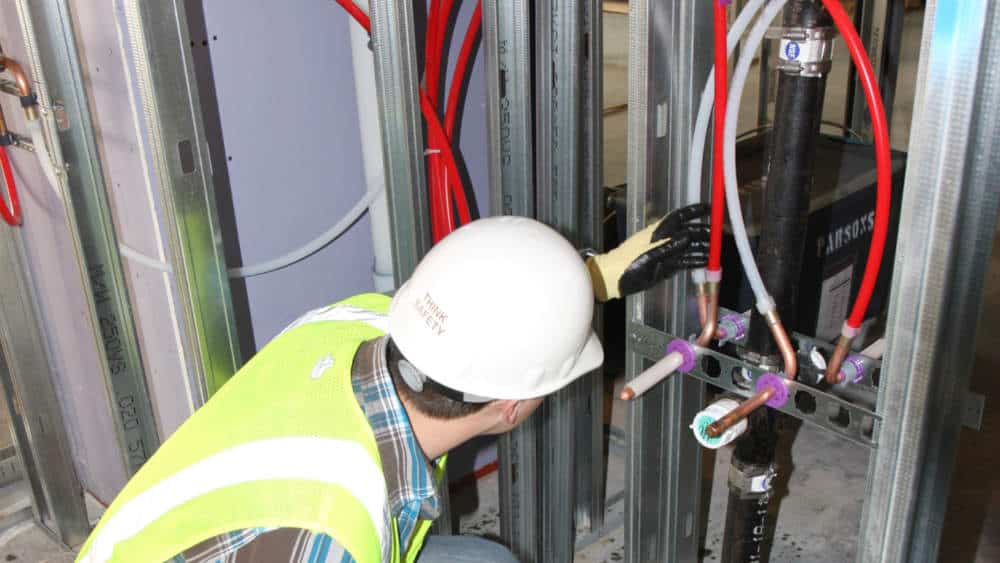
If you are doing a commercial remodel/renovation or building out a new commercial space, you may be wondering which type of plumbing is the best for your business. Since each organization has specific, unique needs, it can be informative to learn about the advantages and disadvantages of each plumbing material and how they could affect your commercial space. We only work with the most qualified plumbing subcontractors to determine the type of plumbing that will work best on each individual job. Overall, while plumbing design is best left to the experts, business owners, property managers, brokers, home owners, and more can all benefit from learning more about what to expect when deciding on the types of plumbing described below.
PEX (Cross-Linked Polyethylene)
PEX entered the market in 1993, and has grown exponentially in popularity. PEX is flexible, so it can weave through walls ceilings, basements, & crawlspaces, but it is also rigid enough to withstand the pressures of water supply.
PEX Pros
- Can last even longer than copper & CPVC
- Competitively priced– cheaper than copper and about the same price as CPVC
- Color-coded: red for hot water & blue for cold water
- Highly flexible (90-degree curves possible)
- Fewer joints & weak spots that other types of pipes
- Attaches with push-fit plumbing fittings
- Able to join with copper pipe
- Cuts easily
- Easier & faster to install than copper
- Won’t corrode like copper. PEX is unaffected by acidic water
- Can resist bursting due to frozen lines, unlike copper and CPVC
- Comes in long lengths
- Fire safe
- Can reduce hot water expenses because it insulated better than metal
PEX Cons
- Extended Long-term capabilities are untested
- May leak with push-fit plumbing fittings
- Cannot be recycled
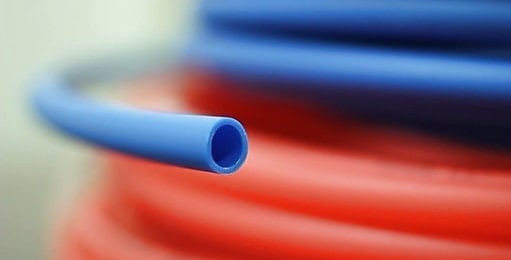
Photo: Super Brothers Repipe
Photos: Plumber Mag
Other Plastic
PVC (Polyvinyl Chloride)
Having been used as far back as the 1930’s, PVC is commonly utilized for drainage, water mains, and vent lines. PVC is moderately easy to install and requires little more than a hacksaw, a miter box to cut, and solvents to glue pipes together. PVC is often white but it can also come in other colors.
CPVC (Chlorinated Polyvinyl Chloride)
CPVC is usually an off-white plastic. It used for both cold and hot water because it can typically handle up to 180 degrees F. CPVC is the same outside diameter as copper and PEX and uses the same push-fit fittings, such as SharkBite.

Photo: Plumbing in Carlsbad
PVC/CPVC Pros
- Time tested– long-term use with very few defects or problems.
- One of the most inexpensive pipe materials available
- CPVC can handle extreme temperatures up to 180°F making it a good choice for hot water
- Won’t corrode/rust like copper
- Easy installation with less chance than copper & PEX of installer error
- Diameters clearly marked on the pipe
- Can be used for long runs such as for irrigation
- Flexible
PVC/CPVC Cons
- Can’t be used as exterior exposed piping– when exposed to sunlight for extended periods it breaks down/becomes brittle.
- Does not react well to bug sprays or chemicals being applied to it
- Cannot be unjoined and must be cut
- Glued pipes can be prone to leaking
- Fragile and tends to shatter, also can develop stress cracks
- When PVC pipes freeze they tend to split from fitting to fitting
ABS (Acrylonitrile-Butadiene-Styrene)
ABS pipe was developed in the 1950’s. It is not for carrying drinking water and is mainly used as a vent and drain line. It looks similar to PVC pipe, but is black. Many areas don’t allow ABS in new construction because joints can come loose. But, ABS is commonly used to replace old cast iron pipes.
ABS Pros
- Easier to install and less expensive than metal pipes
- Stronger than PVC pipes
- Doesn’t corrode like metal
- Good for underground exterior use
- Works well in cold temperatures
ABS Cons
- Cannot be used as exposed piping
- Bows & sags if installed improperly
- Often not permitted by building code
- Warps and deforms at certain temperatures
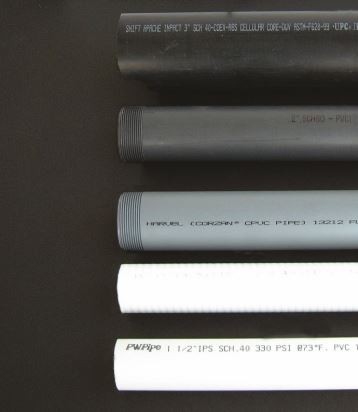
Photo: Water Shapes
Copper
Copper became popular after World War II, when the health dangers of lead were discovered.
Rigid copper is often used for water supply lines because it doesn’t come with any health risks. It comes in three thicknesses, types L & K being suitable for commercial applications. While rigid copper is easily cut with a hacksaw or tube cutter, connecting it requires soldering.
Flexible copper is typically used for short runs to water heaters, fridges, and sinks. It can be bent to fit around corners, but if it kinks that piece must be cut off and replaced. Connections are made with solder or compression fittings.
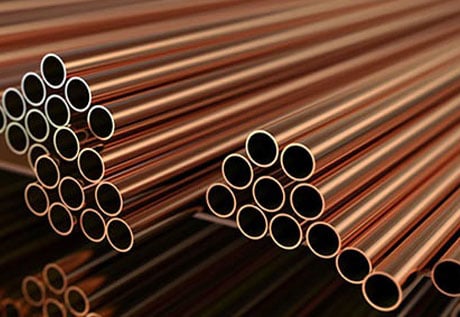
Photo: Solitaire Overseas
Copper Pros
- Can withstand intense pressure
- Handles heat well
- Extremely long lasting (80-100 years)
- Can be used as exposed exterior piping because it stands up to UV degradation
- Exposed copper is aesthetically pleasing
- Easy to recycle & waste copper has monetary value
- Does not expand or contract under pressure or temperature changes like PEX or CPVC.
- Even rigid copper can be slightly bent
Copper Cons
- Labor intensive installation and repair
- Expensive
- Possible slight metallic taste in drinking water it carries
- Can develop pinhole leaks
- Inside of pipe may eventually corrode and impede water flow (accelerated by hard water)
- Can be affected by some soils and should be sleeved if used underground
Galvanized Steel Pipe & Cast Iron
Galvanized pipe is made of steel or iron, coated with zinc. It is considered safe for carrying drinking water, and is still used in commercial water distribution. Galvanized plumbing is strong, connects by screwing pipes together at their threaded ends, and can last up to 50 years until it is thoroughly corroded/rusted out. Cast Iron has been used since the 1960s for drain lines, vent stacks, and in sewers. Cast iron pipe is commonly replaced with plastic pipes such as ABS.
Galvanized Steel & Cast Iron Pros
- Galvanized steel pipe has the advantage of being extremely strong
- Less expensive than copper and are more durable than plastic
- A benefit these metal pipes have over copper is their wider diameter, which allows more water through
Galvanized Steel & Cast Iron Cons
- Heavy to handle & difficult to cut
- Corrosion eventually blocks water flow
- Some galvanized steel may pass lead into water
- Rust on the inside causes plaques to build up that lead to water pressure issues and pipe failure
- Eventually there will be visible impurities in water and a slight metallic taste
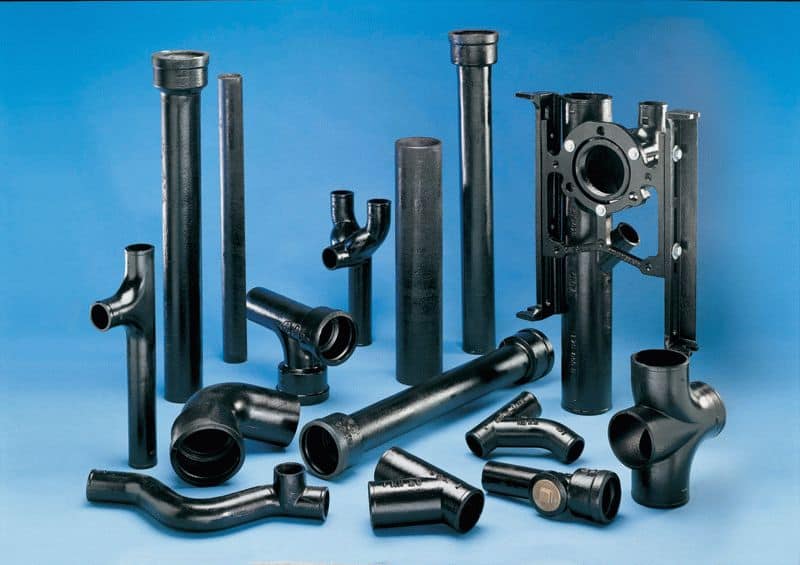
Conclusion
We hope you will call us today at 480-832-9808 or email us so that we can discuss your commercial construction project and what type of plumbing will best suit your needs. As is the case with all other trades, we focus on performing a proper installation from the get-go so that the plumbing can accomplish its function without issues. In the end, by determining the best plumbing match for your business, and trusting us to do the install, you can rest assured that you wisely invested in a system that will function well for many years.
Sources
https://www.abchomeandcommercial.com/blog/galvanized-plumbing/
http://mygeorgiaplumber.com/default.asp.pg-DifferenttypesofPlumbingPipes
http://plumb-tech.com/plumbing-pipe-options/
https://thecraftsmanblog.com/pex-cpvc-or-copper-plumbing/
https://www.thespruce.com/basic-types-of-plumbing-pipes-1822487
https://www.thespruce.com/types-of-pipe-used-for-water-2718736


